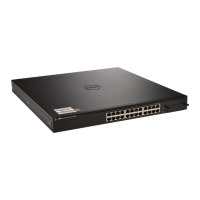558 Configuring VLANs
Voice over IP (VoIP) traffic is inherently time-sensitive: for a network to
provide acceptable service, the transmission rate is vital. The priority level
enables the separation of voice and data traffic coming onto the port.
A primary benefit of using Voice VLAN is to ensure that the sound quality of
an IP phone is safeguarded from deteriorating when the data traffic on the
port is high. The switch uses the source MAC address of the traffic traveling
through the port to identify the IP phone data flow.
The Voice VLAN feature can be enabled on a per-port basis. This feature
supports a configurable voice VLAN DSCP value. This value is later retrieved
by LLDP when the LLDPDU is transmitted, if LLDP has been enabled on
the port and the required TLV is configured for the port.
Identifying Voice Traffic
Some VoIP phones contain full support for IEEE 802.1X. When these phones
are connected to a port that uses 802.1X port-based authentication, these
phones authenticate and receive their VLAN information from LLDP-MED.
However, if a VoIP phone has limited support for 802.1X authentication it
might try to authenticate and fail. A phone with no 802.1X support would not
attempt to authenticate at all. Instead of placing these phones on an
unauthenticated or guest VLAN, the switch can automatically direct the VoIP
traffic to the Voice VLAN without manual configuration.
The switch identifies the device as a VoIP phone by one of the following
protocols:
• Cisco Discovery Protocol (CDP) or Industry Standard Discovery Protocol
(ISDP) for Cisco VoIP phones
• DHCP vendor-specific options for Avaya VoIP phones
• LLDP-MED for most VoIP phones
After the VoIP phone receives its VLAN information, all traffic is tagged with
the VLAN ID of the Voice VLAN. The phone is considered to be authorized
to send traffic but not necessarily authenticated.
NOTE: By default, ISDP is enabled globally and per-interface on the switch.
LLDP-MED is disabled on each interface by default. Port-based authentication
using 802.1X is also disabled on each port by default.

